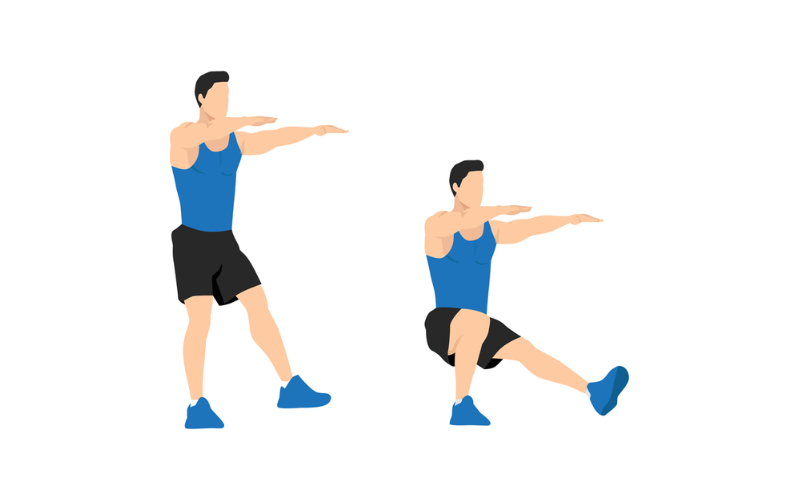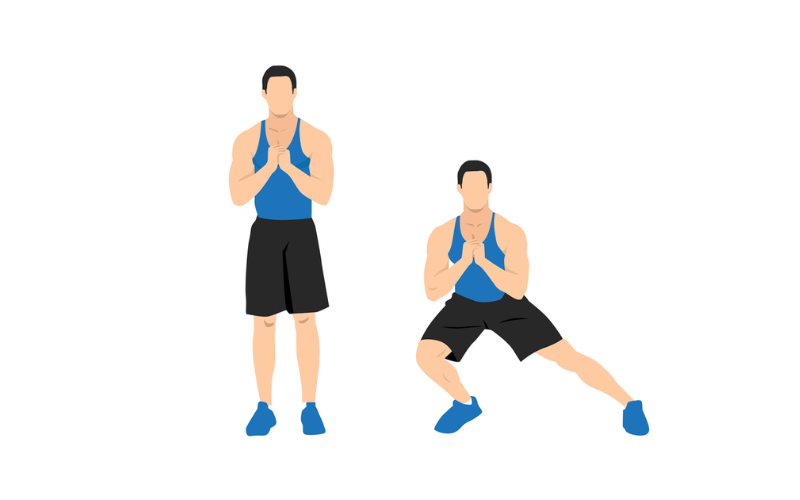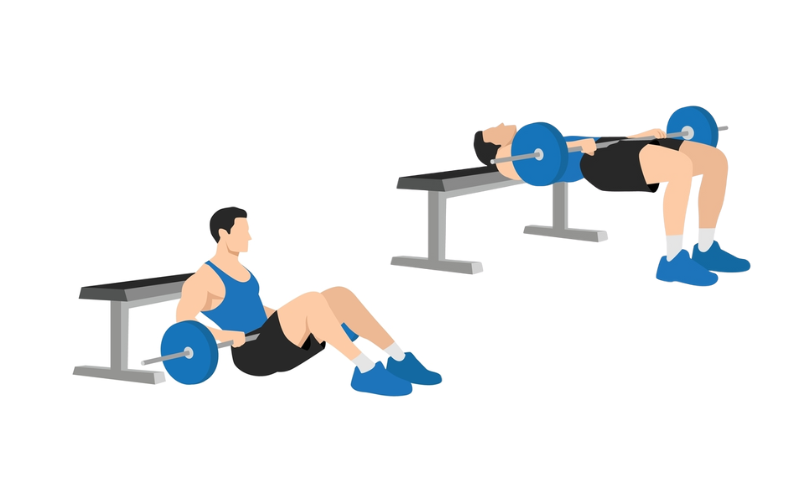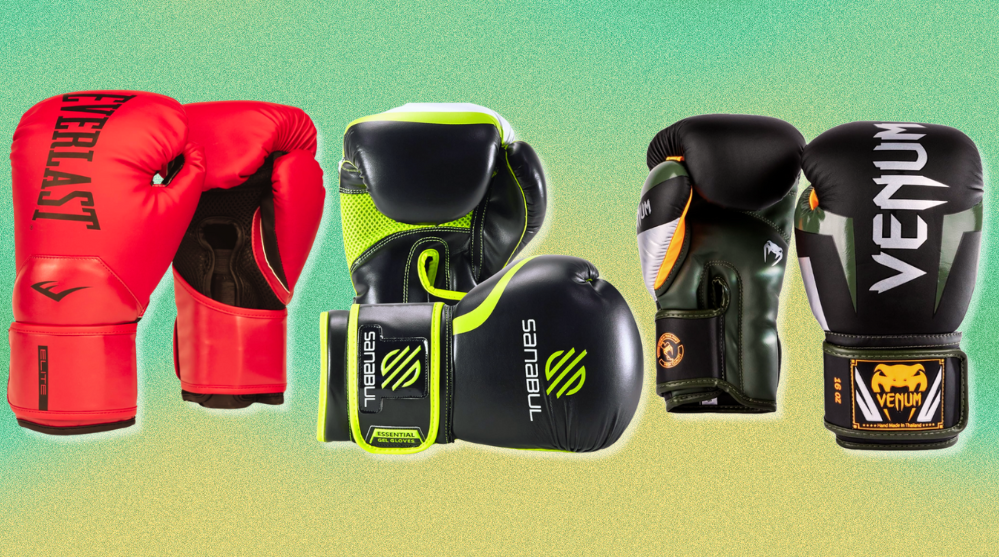Working on your strength one leg at a time is important for staying fit and active. It’s not just about getting bigger muscles; it helps you balance, stand stronger, and keep you from getting hurt by fixing those little strength differences in your legs. This is great for athletes who want to be their best and anyone who wants to feel good daily.
You’ll discover seven awesome exercises you can do on one leg to make your lower body strong. These exercises are good for all kinds of fitness goals, whether trying to improve your sports skills or stay healthy as you age. Adding these to your workout will help you get stronger and more stable.
Besides building muscle, these One Leg Strength Exercises help with coordination and balance needed for everyday life. This means the strength you build in the gym will help you in real life, making it easier to play sports, walk, or climb stairs.
Benefits of One-Leg Strength Exercises
Working on one leg, like single-leg squats, lunges, and step-ups, isn’t a recent fitness fad—it’s a worthwhile method of getting strong and healthy. When you work one leg at a time, your body has to work many more muscles you don’t normally think about, especially in your hips, ankles, and core. This helps you balance more and see if one leg is stronger, which can keep you from getting hurt.
Besides strengthening your muscles, these exercises teach your body to move efficiently and use its strength evenly. This is crucial, especially if you play sports such as running, jumping, or any sport that requires quick movements. Additionally, because you have to involve the core muscles in order to be stable, your back gets stronger, and you can control your body better.
These exercises are accessible to anyone, whether you’re a beginner or an advanced individual. You can perform them using your body weight or add weights for added challenges. Training one leg at a time will strengthen your legs, make you move more effortlessly, and improve your performance in sports and everyday activities. It’s not just about strong legs; it’s about being more agile, balanced, and less injury-prone.
Top 7 One-Leg Strength Exercises
Single-Leg Squat (Pistol Squat)
The single-leg or pistol squat is a powerful exercise that takes your lower-body strength to the next level. It’s not just about showing off – this move seriously boosts your balance, flexibility, and muscle strength, especially in your quads, glutes, and the muscles around your knees. Adding single-leg squats to your routine can be a game-changer for runners or anyone dealing with knee pain. They help strengthen the muscles that support your knees, reducing stress and preventing injuries. Plus, they engage your hip muscles, which keeps your pelvis stable and improves overall lower-body strength.

Image Courtesy: Shutterstock
Doing a single-leg squat properly requires focus and control. Start by standing on one leg with the other leg and your arms extended straight out in front of you. Slowly lower yourself into a squat, keeping your standing knee aligned over your foot. Push your hips back and feel the burn in your quads and glutes as you go down. Then, push through your heel to stand back up. It’s a challenging move, so take it slow and focus on maintaining good form. Aim for 5-10 reps on each leg and gradually increase the depth of your squat as you get stronger.
While single-leg squats are fantastic for building strength and preventing injuries, they can be tough on your knees if you rush into them. That’s why starting gradually and focusing on proper technique is important. Over time, you’ll notice improved balance, stronger legs, and better overall stability. Whether you’re a runner or just looking to level up your fitness, the single-leg squat is a must-try exercise!
Bulgarian Split Squat
The Bulgarian Split Squat is a tough exercise but gives amazing results! You put one foot behind you, grab some weights, and bring your other knee down to near the ground. It’s hard, but it’s worth it! This exercise hits your butt, thighs, and hamstrings big time. It also makes each leg stronger, which regular squats don’t address.

Image Courtesy: Shutterstock
Standing on one leg also enhances balance and coordination. Your core, hips, and smaller muscles must work harder to maintain balance. Athletes love it because it helps with running, jumping, and quick changes of direction, all of which demand strong single legs.
It’s also more gentle on your joints! It’s easier to move your hips and ankles while standing this way, so it’s safer if you’re a bit stiff. It’s also more gentle on your back than deep squats, and you get a good stretch at the bottom of your hip.
You can even mix it up to make it even more challenging! Attempting to descend very slowly, holding the bottom position, or utilizing a new grip to stimulate other muscles will all work! It’s one of the best methods for building muscle, improving movement, and building strength!
Single-Leg Deadlift
This exercise works on each leg individually, allowing you to see if one leg is weaker and may not be caught with regular deadlifts. You’ll feel it in your glutes, hamstrings, and core as you hinge at one hip, keeping your back straight and lowering with your body. It’s not just about getting stronger; it also helps you move better and understand where your body is in space. Athletes love it as it helps with running, jumping, and quick movements and is easier on your back compared to weighted barbell deadlifts.

Image Courtesy: Shutterstock
To do it right, start with a lightweight, stand on one leg with a slight knee bend. Push your butt back as you lower with the weight down towards the ground, keep your shoulders tight, and brace your core. Stop when your hamstring tightens, or your back starts to round—you don’t need to go low. Press through your heel to stand up, and clench your butt at the top. Don’t lift your other leg too high; keep it lightly lifted to help balance.
This exercise is great because it works the back of your leg well and recruits your whole body. Your hamstring and butt do most of the work, but your core has to work hard to stabilize you, and your hip muscles keep you from falling over. In the long term, this helps you perform better in squats, deadlifts, and sports and keeps you from getting hurt. However, don’t rush! Focus on making slow, deliberate movements.
Most people sway or round their backs, especially with heavier weights. If you’re unsteady, start with body weight only or barely touch your toe to the ground. As you get better, add weight or try changing the speed. Try to take 3 seconds to lower the weight. Do this exercise with squats or regular deadlifts for a great leg workout. Do three sets of 8-10 reps for each leg. It’s a tough exercise, but it’s good for you. Stick with it, and you’ll have more stable and stronger legs!
Step-Ups
Weighted Step-Ups are a great exercise that targets the legs and allows you to do activities in daily life more effectively, like stepping onto a ledge or going upstairs. You put a bench or a box in front of you, hold weights like dumbbells or kettlebells, and step up on the bench. It targets your front and back thigh muscles, as well as your glutes. Step-ups put less pressure on your knees than squats or lunges, especially if you have bad knees.

Image Courtesy: Shutterstock
Because you’re doing one leg at a time, you can also tell if one is stronger than the other and compensate. It also helps your balance and coordination. Step-ups are perfect if you’re an athlete wanting to jump higher or run faster or just someone wanting to move around better daily. You can also make them easier or harder by using a lower step to work your front thighs more or a higher step to work your back thighs and buttocks more. You can also add weight to make it harder.
The best part about step-ups is the variety. If you are new to step-ups, you can use your body weight and a low step. Make sure you’re stepping through the heel of your foot, your knee is in front of your toes, and your back is straight. If you’re more advanced, you can incorporate explosive jumps, use a barbell, or change the tempo of the exercise. Explosive step-ups are great for basketball or sprinting-type sports and doing them sideways works the outside of your hips and glutes.
You can also perform them quickly with light weights to achieve a cardio effect. Just keep in mind that the leg not stepping up is only there to help support, not perform any of the work.
The proper form needs to be used to get the most out of step-ups. Prevent your knee from moving towards your body, prevent pushing off the back leg, and keep your back straight. To spare your knees, never let them go past your toes. Maintain your chest up and core tight. If you’re returning from injury, start with no weight and a short step.
Elite competitors can utilize them in their routine for endurance or deadlifts for difficult leg exercises. Do the exercise gradually and correctly, and don’t go too deep too soon. Step-ups are great for building strong legs, getting around more easily, and having healthy joints.
Single-Leg Glute Bridge
The Single-Leg Glute Bridge is another excellent but extremely simple exercise that exercises your butt, hamstrings, and core. You don’t have to go to the gym, though! It’s awesome to do at home. You do each side of your body separately so you can test and see if one is weaker than the other and bring them both up to even. It’s also extremely nice for your lower back. Start by lying on your back with your knees bent and your feet flat on the floor.
Lift one leg straight, then push through the heel of your other leg, squeeze your buttocks, and lift your hips until your body is in a straight line. Pull your pelvis in a little, keep your core tight, and pull your ribs down to keep your back in line. Hold at the top, then lower your hips slowly. This exercise is only done with your body weight, which is excellent for gaining muscle and improving the mobility of your hips.

Image Courtesy: Shutterstock
This exercise is fantastic because it benefits those with injuries and is also safe for your back. By lifting one leg, you get your butt to work even harder, addressing any strength discrepancies that regular squats or lunges may overlook. It also tightens your core, which makes your body more efficient. If you are a beginner, perform a few reps and focus on doing them right rather than lifting your hips high. If you’re advanced, add resistance bands or extend the time in the top position. Do the reps slowly and control them to maximize the exercise.
The Glute Bridge is less stressful on your back than the Single-Leg Hip Thrust, which requires lifting your shoulders and adding weight. It’s ideal for beginners to glute training or those with joint issues. To make it more challenging, lift your shoulders on a bench or place a weight on your hips. But remember, good form is more valuable than many reps. If your back arches or your hips sag, do fewer reps or switch to regular bridges with both legs. Perform this exercise with squats or lunges for a full-leg workout or as a warm-up for your butt muscles before lifting heavy weights.
Lateral Lunges (Single-Leg Variation)
Lateral Lunges are a great exercise that works muscles you do not typically use, like your inner thighs and outer glutes. They are very similar to regular lunges but work to strengthen and improve mobility and balance. By stepping laterally into a low lunge, you work each leg individually, which can assist you in finding and correcting differences in strength. This is wonderful if you’re tired of doing traditional squats or just want to shake things up.
Start with your feet hip-width apart and your hands together in front of your chest. Take a big step to the side, keep your toes facing forward, and sink your hips like you were sitting down. Bend the leg you stepped out with 90 degrees and keep the other leg straight. Push off the back of the heel of the leg you bent to get up. You can feel it in your inner thighs, butt, and thighs. You don’t necessarily need weights, but dumbbells or kettlebells work if you want to challenge yourself more and develop more muscle.

Image Courtesy: Shutterstock
Lateral lunges are great because they’re easier on your lower back than squats, and they force your stabilizer muscles to work more. This also allows you to balance more in day-to-day activities and sports like skiing, where strong inner thighs are assets. They also work your inner thighs, which most leg exercises do not. If you are a novice at this exercise, hold onto a chair or wall for support. If you are advanced, do a Cossack squat or add an upright row with a kettlebell. Just make sure you keep your chest up and back straight.
Ensure you step out far enough and don’t allow your knee to extend beyond your toes. Your front knee should be directly above your ankle. If pregnant, you might want to do shallow lunges or skip the weights and discuss with a trainer beforehand. If you have knee problems, be gentle and stop if you feel pain. Make lateral lunges to supplement squats or deadlifts for a complete leg workout or as a warm-up. This exercise is great for training for skiing, giving your legs the same strength, or adding some variety to your leg workouts.
Single-Leg Hip Thrust
This exercise is amazing for working your butt muscles! It hits all the glute muscles and helps you learn to use one leg at a time, which is perfect for fixing any strength differences and making both legs equally strong. You start by putting your upper back on a bench, plant one foot firmly on the ground, and lift the other leg with your hip and knee bent at 90 degrees. Then, push through the heel of your planted foot and lift your hips until they’re in line with your body, squeezing your butt at the top.
Lower your hips slowly and repeat, then switch legs. You don’t need a barbell for this; your body weight is enough, but you can add a dumbbell or resistance band to make it harder.

Image Courtesy: Shutterstock
Why is this exercise so great? It’s the best for working the muscles you use when you stand, run, and jump. Studies have shown that hip thrusts work your butt muscles better than deadlifts, which is great for athletes and anyone who likes to be active. Working one leg at a time, you find and fix any weaknesses, ensuring both sides are strong. Plus, it’s easy on your back, unlike heavy squats. This makes it perfect for runners, skiers, or anyone who climbs stairs because stronger glutes mean better performance and fewer injuries.
But you need to do it right. Don’t arch your back or push with your elbows instead of your butt. Keep your chin tucked and ribs down, and focus on pushing through your heel, not your toes. If you’re struggling, try doing a two-leg hip thrust and then lowering on one leg. If you’re advanced, add a resistance band or try weighted variations. If you want an extra challenge, hold the top position for a few seconds to feel the burn.
The Single-Leg Hip Thrust is perfect whether you’re recovering from an injury, getting ready for skiing, or want to try something different from squats. It’s easy to adjust to your level, doesn’t need lots of equipment, and is super effective. All you need is a bench, determination, and a willingness to feel the burn. So, next time you work out your legs, try this exercise and get ready for a stronger, more resilient butt!
Tips for Maximizing Results
Working out one leg at a time is a fantastic way to get stronger, have better balance, and make sure both legs are equally strong. But to get the best results, you need a good plan! First, focus on doing the exercises correctly. Keep your knee in line with your toes and back straight and tighten your core muscles to protect your back and work your muscles the most. Start with exercises like single-leg squats, lunges, and step-ups using just your body weight. Add weights like dumbbells or resistance bands to make it harder as you get stronger.
To keep your workouts fun and effective, try different exercises. Add harder variations like Bulgarian split squats, single-leg Romanian deadlifts, or pistol squats to work different muscles and avoid getting stuck. For an extra challenge to your balance, try doing these exercises on wobbly surfaces like a Bosu ball or wobbleboard. This will strengthen your legs and improve how well your body knows where it is in space, which is important for everyday activities and sports.
Do these exercises two to three times a week, and give your muscles at least two days of rest in between to recover. For a complete leg workout, do these exercises along with regular squats and deadlifts. Always warm up with stretches before you start and cool down afterward to avoid injuries and improve flexibility.
Keep track of your progress! Use fitness apps or a notebook to write down how many reps and sets you do and how much weight you lift. Celebrate small wins, like adding more weight or balancing better, because that means you’re improving! Drink plenty of water, eat healthy foods, and get enough sleep to help your muscles recover and grow. By following these tips, you’ll build stronger, more balanced legs and feel more confident overall.
Wrapping Up
And there you have it—one-leg strength exercises that will make your legs feel ready to carry you to superhero status! Whether you’re squatting on one leg or lunging like a pro, your legs will thank you with better balance, strength, and maybe even a few extra inches on your vertical jump (don’t expect to fly… yet).
So, take a deep breath, grab your favorite workout gear, and prepare to make those one-legged moves. Sure, it might feel awkward at first—like you’re trying to be a flamingo—but your legs will be stronger for it. Keep it fun and consistent; before you know it, you’ll be walking (or jumping!) around like a total leg legend.
Now, go ahead and give those one-legged exercises a try. We promise it’s worth it—and hey, if you fall a couple of times, at least you’ll have some great stories to tell!
And if you’re looking to take your fitness journey to the next level, don’t forget to check out our blog on the 7 Best Gym Machines for Weight Loss That Work Wonders. From treadmills to rowing machines, we’ve got the ultimate guide to help you burn fat, build strength, and feel unstoppable. Your fitness journey is just getting started—let’s crush those goals together!



